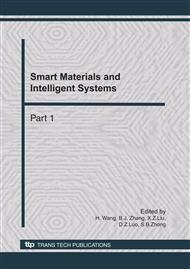[1]
D. Lee, and H. Seung, Learning the parts of objects by non-negative matrix factorization. Nature, Vol. 401 (1999), pp.788-791.
DOI: 10.1038/44565
Google Scholar
[2]
I. Buciu, and I. Pitas, Application of non-negative and local non negative matrix factorization to facial expression recognition. ICPR, Cambridge, Vol. 9 (2004), pp.505-511.
DOI: 10.1109/icpr.2004.1334109
Google Scholar
[3]
C. Lin, Projected gradient methods for nonnegative matrix factorization. Neural Computation, Vol. 19 (2007), pp.2756-2779.
DOI: 10.1162/neco.2007.19.10.2756
Google Scholar
[4]
I. Buciu, and I. Nafornita, Non-negative Matrix Factorization Methods for Face Recognition under Extreme Lighting Variations. in Proceedings, (2009), pp.125-128.
DOI: 10.1109/isscs.2009.5206186
Google Scholar
[5]
J. Lu, and Y. Tan, Doubly weighted nonnegative matrix factorization for imbalanced face recognition. in Proceedings of IEEE International Conference on Acoustics, Speech and Signal Processing, (2009), pp.877-880.
DOI: 10.1109/icassp.2009.4959724
Google Scholar
[6]
M. Turk, and A. Pentland, Eigenfaces for Recognition. Journal of Cognitive Neuroscience, Vol. 3 (1991), pp.71-86.
Google Scholar
[7]
C. Lei, and Z. Yong-Sheng, Time-frequency Spectra Recognition Based on Sparse Non-negative Matrix Factorization and Support Vector Machine. ACTA AUTOMATICA SINICA, (2009).
DOI: 10.3724/sp.j.1004.2009.01272
Google Scholar
[8]
R. Sandler, and M. Lindenbaum, Nonnegative Matrix Factorization with Earth Mover's Distance Metric. in Proceedings of IEEE Conference on Computer Vision and Pattern Recognition, (2009).
DOI: 10.1109/cvpr.2009.5206834
Google Scholar
[9]
S. Choi, Algorithms for orthogonal nonnegative matrix factorization. in Proceedings of IEEE International Joint Conference on Neural Networks, (2008), pp.1828-1832.
DOI: 10.1109/ijcnn.2008.4634046
Google Scholar
[10]
I. Buciu, and I. Pitas, NMF, LNMF, and DNMF modeling of neural receptive fields involved in human facial expression perception. Journal of Visual Communication and Image Representation, Vol. 17 (2006), pp.958-969.
DOI: 10.1016/j.jvcir.2006.06.001
Google Scholar
[11]
X. Li, and K. Fukui, Fisher Non-negative Matrix Factorization with Pairwise Weighting. in Proceedings of IAPR Conference on Machine Vision Applications, (2007), pp.380-383.
Google Scholar
[12]
S. Li, X. Hou, H. Zhang, and Q. Cheng, Learning spatially localized, parts-based representation. in Proceedings of IEEE Conference on Computer Vision and Pattern Recognition, (2001), pp.1-6.
DOI: 10.1109/cvpr.2001.990477
Google Scholar
[13]
M. Lyons, J. Budynek, and S. Akamatsu, Automatic classification of single facial images. IEEE Transactions on Pattern Analysis and Machine Intelligence, Vol. 21 (1999), pp.1357-1362.
DOI: 10.1109/34.817413
Google Scholar
[14]
Y. Wang, Y. Jia, C. Hu, and M. Turk, Non-negative matrix factorization framework for face recognition. International Journal of Pattern Recognition and Artificial Intelligence, Vol. 19 (2005), pp.495-512.
DOI: 10.1142/s0218001405004198
Google Scholar
[15]
M. Lyons, J. Budynek, and S. Akamatsu, Automatic classification of single facial images. IEEE Transactions on Pattern Analysis and Machine Intelligence, Vol. 21 (1999), pp.1357-1362.
DOI: 10.1109/34.817413
Google Scholar


